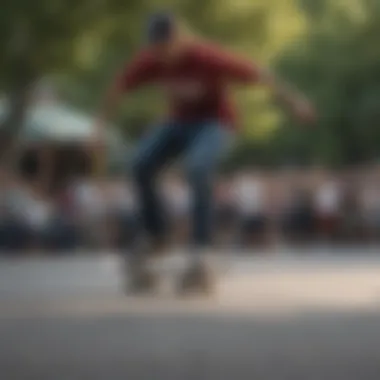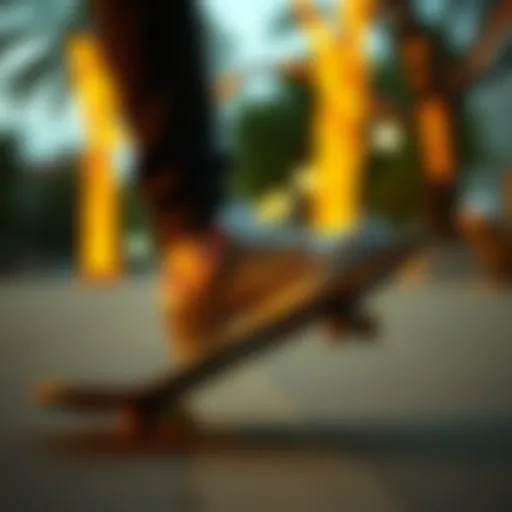Exploring the Significance of Ako Williamsburg in Skate Culture


Intro
The Ako Williamsburg skateboarding community is a vibrant and essential part of the larger skate culture. This section will pull together various aspects such as key influencers, local events, and park accessibility, showing how it ushers in a new era for skateboarding.
Preface to Ako Williamsburg
The skateboarding scene in Ako Williamsburg holds significant importance within the larger context of global skate culture. This area is not just clad in concrete ramps and streets; it serves as a benchmark for many emerging skateboarders. Understanding Ako Williamsburg provides valuable insights into the evolution and dynamics of skate communities in urban environments.
In Ako Williamsburg, the blend of culture, location, and community engagement is evident. The influence of artistic expression is palpable, where skating intertwines with elements of urban art and music. This rich background contributes to a distinct community that attracts both local enthusiasts and tourists alike. The vibrancy of the area can be felt in its shared spaces and neighborhood interactions, enhancing the skateboarding experience overall.
Important themes specific to this area, such as diversity in skills and the accessibility of parks and events, make it a fascinating topic for analysis. The initiatives that engage young skateboarders also play a role in shaping the future of the sport. By exploring these themes, readers can appreciate how Ako Williamsburg is not merely a habitat for skaters but a pivotal environment that promotes welfare and connection.
Moreover, the skateboarding culture here influences broader trends by intersecting with urban change and community identity. It embodies a unique environment that helps evolving skateboarders define their styles and aspirations, tightly integrated with their surroundings.
In summary, the depth that Ako Williamsburg brings to the skateboarding world cannot be overstated. Engaging with the principles presented in this section facilitates a broader understanding of the implications of contemporary skateboarding and emphasizes the importance of community within a sport that often seems isolated.
"Skateboarding is not just an action sport; it's an art form, a means of expression, and a community-bound journey."
By recognizing these various elements, we can gain a more layered understanding of Ako Williamsburg as it pits itself against not just styles or skillsets but vital connections that compel it toward future growth.
Historical Context
Understanding the historical context surrounding skateboarding in Ako Williamsburg offers insights into its evolution and significance. Skate culture has roots that intertwine various social movements and urban lifestyle changes. This section will illustrate how local events and shifts within the community impacted the current state of skateboarding here.
Early Beginnings of Skate Culture
Skateboarding began in the late 1940s and early 1950s as surfers in California sought to find an alternative activity for rideable surfaces when the waves were flat. It was an informal choice. The skateboard suited the needs of this emerging culture. As time passed skateboarding became more structured, innovating techniques and equipment. By the 1970s, the sport started to garner attention globally.
In the 1970s, early skateboarding boards were mainly produced using wood and often were bulky. The wheels were rough and made riding a challenge. However, the growing interest led manufacturers to explore new technologies. Development of lighter materials and better wheels gave emergence to smoother rides. Several skate spots, which became crucial for tricks and meets arose in urban areas.
As the culture expanded, it began attracting disparate localities. Street skating emerged. This urgent and unsanctioned manner of skating involved utilizing city structures like stairs, ledges, and railings. It paved the way for riders in Ako Williamsburg long before skate parks established grounding. Local enthusiasts began discovering spots to practice.
Development of Skateboarding in Williamsburg
The transition of Williamsburg into a vibrant skate community began in the 1980s but notably surged in the 1990s and early 2000s. This time marked significant changes not only in the skate scene but also in the surroundings of the neighborhood. With developments like the reopening of local ghost warehouses for creative spaces and new demographics moving in, an environment suited for skate culture flourished.
The art and music scene in Williamsburg catalyzed community initiatives for DIY skate parks that quickly gained strength. Ramps and obstacles began emerging almost everywhere, most often through collective efforts by skateboarders pushing to optimize less used areas. Local organizations played key roles in providing spaces that offered connection and experimentation for skaters.
Development catches attention from both skaters and local authorities insightful of potential city attraction challenges.
SkRoster emerges as popular among local skaters connecting them to knowledge and event calendar aspects. If you are exploring skate compettions, utilize the community discussed on Reddit.
By acknowledging these historical roots, one can see how they helped shape what Ako Williamsburg is today in the skate community. It is pivotal to blend skater creativity, evolving features, and urban implications in understanding the area.
Key Skate Parks in the Area
Skate parks are crucial to any vibrant skateboarding community. In Ako Williamsburg, these spaces are not just concrete structures; they are essential ecosystems thriving with energy and creativity. Key skate parks foster an environment where skaters can practice, innovate, and connect. Through unique designs and facilities, these parks meet the various needs of skateboarders at all levels of expertise.
Pivotal Locations for Skaters
Several skate parks in Ako Williamsburg stand out as important venues for both seasoned skateboarders and newcomers. Each park contributes uniquely to the community. Popular spots include the Williamsburg Skate Park, which has a history of encouraging local talent. The park features a mix of ramps, bowls, and street elements that cater to diverse skating styles. Another notable place is North Brooklyn's informal rail spots, where street skaters gather to practice their tricks in more realistic settings.
The community around these parks often defines the skating experience. Here, younger skaters learn from veterans, and friendships form over shared passions. These locations not only serve as training grounds but are also venues for events and competitions.


Notable Events and Competitions
Notable events and competitions form an integral part of any community, especially within the texture of skateboarding culture. For Ako Williamsburg, these gatherings not only spotlight the talents within the local skater community but also nurture camaraderie and collective identity. Such events are not mere contests; they are milestones that bring skaters together, bridging generational gaps and enhancing community spirit. Participation in these contests can open doors for locals, encouraging both budding talent and seasoned skateboarders to showcase their skills.
Annual Skate Contests
In Ako Williamsburg, the annual skate contests stand out as key events that attract skaters from various demographics. The energetic vibe created during these contests is unmistakable. Participants train rigorously to impress judges and onlookers, while spectators cheer passionately, creating an electric atmosphere. These contests serve multiple purposes, including promoting local skateboarders and fostering competitive spirit.
Some notable aspects of these contests include:
- Skill Development: They challenge participants to elevate their performance.
- Networking Opportunities: They provide a platform for skaters to connect with potential sponsors and industry professionals.
- Local Business Support: Many events are sponsored by local shops, which boosts the economy and strengthens community ties.
Participants often highlight the sense of belonging felt during organized contests. Through preparation and participation, skaters build skill sets transcending the sport, learning discipline, resilience, and collaboration.
Community Gatherings and Festivals
In addition to competitions, community gatherings and festivals enrich the social fabric of Ako Williamsburg's skate culture. These occasions are less about competition and more about celebration. They create an environment where all enthusiasts, regardless of skill level, can come together to enjoy skateboarding. Activities might include music performances, art displays, and workshops that teach various aspects of skating or skateboard maintenance.
Such gatherings offer substantial benefits, including:
- Cultural Exchange: They promote diversity and bring different opinions and styles together.
- Youth Engagement: These festivals often attract younger crowds, fostering a love for skating in the next generation.
- Resource Awareness: Local organizations often participate, offering information about health, skateboarding education, and support programs.
Influential Figures in the Community
The skateboarding community in Ako Williamsburg is enriched through the contributions of various influential figures. These individuals not only push the boundaries of skateboarding but also imprint their vision on the idyllic skater environment. They act as role models, inspiring the next generation of skaters while also advocating for recognition and resources that promote this urban sport.
Skateboarders Who Shaped Ako Williamsburg
Prominent skateboarders have left a significant mark on Ako Williamsburg, establishing this spot as a hub for innovation and skill. Notable figures such as Joey Pepper and Chuck TREE have come to epitomize skate culture in this area.
- Joey Pepper: Known for his individual style and impactful video parts, Joey has influenced countless skaters who follow his lead. His approachable persona and consistent encouragement of newer skaters foster a welcoming atmosphere in the community.
- Chuck TREE: With remarkable technical prowess, he promotes creativity in skateboarding. Through workshops and demonstrations, Chuck shares his knowledge with aspiring skaters, ensuring the growth of talent in the area.
These skaters also participate in local events, making them accessible to the youths of Waikeningburg. Their presence drives motivation and builds community spirit among diverse skill levels.
Roles of Local Shops and Organizations
Local skate shops and organizations are crucial to the infrastructure of Ako Williamsburg. These entities serve more than just a retail purpose; they form the backbone of the skater community. They provide resources such as skate equipment, apparel, and expert advice on training and skill enhancement.
Key Roles of Local Shops:
- Gathering Spots: They create a safe and inclusive atmosphere where skateboarders can connect, share experiences, and foster friendships.
- Support Circuit: Through donations and sponsorships, they ensure skaters can access necessary resources to pursue their passion including gear and opportunities for competition.
Prominent Organizations:
- Williamsburg Skate League: This organization coordinates competitions that attract skill levels altogether, maintaining a focus on community engagement.
- Pipeline: Known for its non-profit initiative that integrates teaching sessions, targeting youth development in skateboarding for comprehensive learning experiences.
“Skateboarding is not just about tricks. It’s about community and shared passion,” reflects a local shop owner.
Through their combined efforts, local figures and shops help Keeo skateboarding alive in a pandemic-affected world and act adaptively to the changing urban landscape. Their influence is a steady reminder that within every trick and every meetup there is a larger culture connecting every skater.
Emerging Trends in Skateboarding
Emerging trends in skateboarding serve a vital role in the continual evolution of the community.理解 These trends influence how skateboarding is perceived and how local skaters engage with the culture. The significance of tracking these movements allows skaters to adapt both creatively and practically. They may enhance participation, stimulate upward growth in techniques, or invite new approaches to the sport.


Shifts in Popular Styles and Techniques
In recent years, the skateboarding community has witnessed important shifts regarding style and techniques. Traditional styles like street skating remain popular but new forms including freestyle and bowl skating have begun to gain momentum. Skaters are seeing innovation through incorporating elements from other activities, like parkour and surf-style maneuvers. This melting pot approach not only appeals to younger skaters but keeps older crowds refreshed about familiar styles.
Moreover, the aesthetic of skateboarding has seen updates, too. The visual aspects of skateboards, from their designs to shapes, mirror broader cultural shifts. Bright colors, unique graphics, or minimalistic looks can all denote a skateboarder’s personality. These artists on shows or manoeuvres bring attention back into areas that may previously seemed conventional or even dated within the industry.
Influence of Technology on Skateboarding
The influence of technology on skateboarding is not a matter I'm discussing lightly. Revolutionary figurations throughout technologysuch as boosted boards and online skateboarding tutorials have helped shape modern skateboarding.
"Tech advancements not only improve performance but reshape how riders connect globally."
For instance, social media tools facilitate global interactions, expanding scope not just for rider-to-rider connection but in collaboration on creative projects. The YouTube channels where sick moves are shared rapidly help to inspire originality while encouraging practice reps. Now, every skater can see tips about perfecting flips or grinds just through a quick search online.
Through software similar to virtual land development apps, skaters plan their journeys for trials in parks, skateboard trips to new cities and more. Tech products designed for improved safety, like smart helmets and rail protection gear also show commitment towards changing skateboarding with a forward view on riding limitations.
Filters, Shine adjustments and responsiveness in professional environmennt set a new standard, much needed in a largely physical sport. Keeping free of unnecessarily complex structures, smoothness of one's motion becomes clearly address during practice in varied environments, including competitions. Thus, merging technology with skateboarding creates potentially ground-breaking opportunities for the community and consumer alike.
Skateboarding and the Urban Landscape
Skateboarding occupies a unique niche within the urban landscape. It serves not just as a sport but as a form of expressive culture deeply connected to the environments where it flourishes. This relationship demands critical attention, particularly as urban spaces often evolve amidst higher real estate demands and population changes. When skateboarders choose spaces for their practices, they select locations that respond to their needs but also reflect social and economical shifts.
Two relevant elements consistently emerge in the context of the skateboard culture: impact of gentrification and public space utilization.
Impact of Gentrification on Skate Culture
The term gentrification refers to the process where wealthier individuals move into a neighborhood, often displacing the original, lower-income residents. This process has significant implications for local skate cultures. In places like Williamsburg, where high demand for housing has risen, the impact on skateboard scenes can sometimes be disruptive. Rent prices set upwards tension on community spaces where skaters have historically forged connections. Digital platforms and social variances often bring a wave of newcomers. These new resident may not understand skate culture or share the same adaptive practices that long-term locals have cultivated.
Those who frequent skate spots in gentrified areas might find themselves confronted with limited access to previously accessible locations. Tensions can escalate between newer populations and skateboarders, leading to oversight of community centric events and chaos within skate culture. Steele Park, a landmark for many skateboarders, exemplifies how community involvement is tested amid rising new developments.
Adjustment trends within gentrifying areas include attempts by skateboarders to re-establish their relationship with shifting urban territory. Gathering in lesser-known locales is becoming a common strategy to evade the tensions that colors spaces entwined within economic conflict.
Public Space Utilization for Skateboarding
The proficient use of public spaces by skateboarders highlights the continuing challenge and beauty of urban design. In cities, public landscapes can often present obstacles for effective skating, but skaters frequently turn these trivial barriers into improvisational challenges. Parks, plazas, and similar environments provide necessary space for practice and performance. This not only contributes to the culture but encourages inclusivity across diverse participant profiles.
Certain guidelines can result from scrutiny of municipal laws seemingly prohibiting skaters from claiming spaces. However, evaluations indicate many successful utilizations of available areas can circumvent potential legal impositions. Spatial relevance remains crucial. Good examples stand in hopeful conflict, since local groups engage municipal government on the potential worth residing in safe and hospitable environments.
Public space projects tailored for skateboarders can improve community relations and foster youth engagement. By organizing skate programs or utilizing park design funding to improve a community campus, urban landscapes adapt continually to meet skaters' demands.
Local Community Initiatives
Local community initiatives in Ako Williamsburg play a vital role in fostering a positive environment for skateboarders, especially the younger demographic. These programs not only encourage skateboarding as a sport but also instill a sense of community among participants. Engaging diverse youth populations, these initiatives bridge gaps and provide pathways to growth and social interaction.
Despite challenges in urban spaces, the community is often resourceful, creating programs that offer mentorship and support. Teaching essential skills, such as skating techniques or social interaction, advantages the participants tremendously. This holistic approach benefits not just the young skaters, but the community as a whole.
The following sections will delve deeper into specific initiatives that enhance the culture of skateboarding within Williamsubrg.
Programs Supporting Young Skaters
Various programs aim to support and develop young skateboarders. These include workshops, training sessions, and youth skate lounges designed to promote skill development and social engagement. Here are several key aspects of these programs:
- Mentorship opportunities: Experienced skaters provide guidance and teach valuable techniques.
- Event organizations: Local agencies frequently host competitions, enabling skaters to put their skills to the test.
- Access to the right equipment: Programs often supply skateboards, which remove barriers for those who may not have access to quality gear.


Youth-oriented skate programs create a nurturing space for skaters to pursue their interests in a supportive atmosphere. Such encouragement often translates into broader life skills and promotes both self-confidence and resilience.
Collaboration with Schools and Organizations
Partnerships between local schools, youth organizations, and skateboarding entities serve to enhance the initiatives designed for younger skaters. Such collaborations typically involve intertwined objectives focused on health, fitness, and personal growth. The following points outline the importance of these collaborations:
- Integration into academic programs: Several schools have begun incorporating skateboarding into physical education courses, making it more mainstream.
- Workshops and after-school clubs: Local organizations frequently organize workshops where the specifics of skateboarding are taught, ensuring proper techniques and safety.
- Utilization of public space: Schools and councils work together to create safer and designated areas for students to skate, allowing for both recreational and social interactions.
Overall, these collaborations bolster community identity and promote skateboarding among youth. They generate deeper connections between local impiss and ultimately make the skatin community stronger.
Sustainability in Skateboarding
Sustainability in skateboarding is becoming increasingly vital as the sport grows. As the community expands, so does the need to ensure that the environment remains a priority. Skateboarding does not exist in isolation. It interacts with urban spaces, landscapes, and local communities. By prioritizing eco-friendly initiatives, skateboarders contribute to a healthier environment and a sustainable future for the next generations of skaters.
Practices that focus on sustainability within the skateboarding culture include not just environmental awareness but also social responsibility. In towns like Williamsburg, skateshops, parks, and local organizations are becoming more engaged in sustainability efforts.
Eco-Friendly Practices in the Community
Local skaters are adopting various eco-friendly practices. For instance, community groups organize park clean-ups. By gathering skaters, they encourage responsibility toward the local environment. Frequent clean-up events help keep public spaces clear of litter and debris while forging stronger community ties.
When creating parks, eco-conscious design elements are essential. Many newer skate parks in Williamsburg incorporate permeable materials for surfacing which allows rainwater to seep through. These designs can lead to the reduction of water runoff and pollutant discharge. Skateparks such as the East River State Park are exemplifying sustainable design strategies and promoting awareness among users.
Recycling skateboards is another growing trend. Some groups offer to help refurbish used boards, which lessens landfill waste. Skateboarders can often donate old skateboards. These can be repurposed for community art projects or sent to less fortunate youth learning to skate.
The Role of Local Vendors in Promoting Sustainability
Local vendors play a significant role in the sustainability movement within the skateboard scene. Many shops are consciously stocking eco-friendly brands that produce skate-related products, such as recycled skateboards or organic apparel. Vendory like Blank Skateboards utilizes materials that minimize environmental impact, which resonates with eco-five-skateboarders.
Vendors are not just selling; they are organizing workshops aimed at educating the community. These sessions explore the importance of sustainability within skateboarding. Community ideation centers and local NGOs often partner with stores to promote these ideals.
In closing, sustainability in skateboarding encompasses a multifaceted approach where individual actions aggregate to represent community values. Whether through eco-friendly practices or local vendor advocacy, the inability to weight the health of the environment affects everyone, including skaters. The skateboard community in Williamsburg is creating a movement where spirits ride along with eco-conscious choices; it's being laid out in continual grind and spin.
“Ultimately, skateboarding can either contribute to environmental degridation or an ecological balance, the choice belongs to the community.”
The attention to sustainable practices is transforming the skateboarding scene into a more inclusive and helpful culture for everyone. With the support of informed enthusiasts, skateboarders, vendors, and locals can come together to elevate both the skateboarding experience and the environment.
Finale: The Future of Ako Williamsburg
The future of Ako Williamsburg is pivotal in understanding not just the local skateboarding community, but also its role in the larger context of urban culture. As the skate culture evolves, so does the very essence of this community. The interconnection between skateboarding and urban development raises crucial questions about sustainability, identity, and accessibility. A vibrant community spot that draws skaters of varying skill levels continues to grow, adapting and redefining itself to larger social themes
Prospects for Growth and Development
Growth within Ako Williamsburg is a multi-faceted endeavor. At one level, it hinges on the enhancement of local facilities and introducing innovative skate areas that cater to a wide spectrum of skaters. These facilities have the potential to become community hubs, fostering talent and creativity.
Factors influencing further growth include:
- Local Initiatives: Groups and organizations actively engaged in promoting skating can attract a broader audience.
- Support from Local Businesses: Partnerships with skate shops and food vendors play a critical part in maintaining thriving facilities.
- Diverse Events: Hosting competitions, workshops, and community gatherings can create greater interest and bring new participants.
These elements resonate well with the need to create additional value. Skaters can network, and learn, bringing a fresh dynamism to Ako Williamsburg. Adequate support for new talents can lead to their carving a niche, thereby shaping a vibrant ecosystem.
Maintaining Community Identity and Culture
As the landscape continues to shift, retaining the core identity and culture of Ako Williamsburg emerges as a substantial consideration. The importance of community identities in skateboarding should not be understated. Transitions in demographics and popular trends could erode long-established cultures.
Strategies to uphold community identity and culture include:
- Cultural Preservation Efforts: Document efforts, both past and ongoing, to realize the foundational stories of future generations.
- Inclusivity: Focus on welcoming skaters of various backgrounds and experience levels fosters a sense of camaraderie. Activating different voices will retain orchestra amongst the diverse fabric of the community.
- Promoting Local Talent: Strategies to spotlight local skateboarders can inspire a connection with younger members as they seek representation in their community.
Acting proactively about these dimensions is required to prevent the dilution of identity amid growth. It is a balancing act that sustains the core community fabric while continually embracing new developments. Maintaining diversity ultimately results in a rich, harmonious connection among skateboarders that transcends physical space.
The future of Ako Williamsburg not only lies in expansion but also rests in nostalgia and relevance. Skateboarding is inherently historical and future-centric; any endeavor must preserve that connection.







